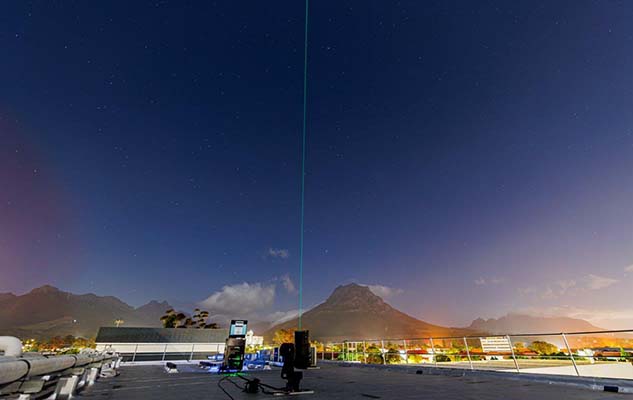Our Terms & Conditions | Our Privacy Policy
Quantum scientists connect SA, China to shatter satcom record
SOUTH AFRICA-CHINA
![]()
Researchers from South Africa and China have set a new world record in quantum communication, establishing the longest intercontinental, ultra-secure quantum satellite link to date. It also marks the southern hemisphere’s debut in quantum satellite communication.
Researchers at Stellenbosch University (SU) in South Africa and the University of Science and Technology of China (USTC) connected the two countries over 12,900km in an experiment conducted in October 2024. Encrypted images were securely transmitted between ground stations in the two countries via Jinan-1, a Chinese quantum microsatellite in low-Earth orbit.
The experiment results were published in Nature on 19 March 2025, according to a news statement SU issued on the publication date. The authors are Dr Yaseera Ismail, Professors Francesco Petruccione and Juan Yin and Jian-Wei Pan.
‘Unbreakable encryption’
At the project’s core is quantum key distribution (QKD), which uses quantum mechanics to generate encryption keys. In the demonstration, quantum keys were created in real time, securing the transmitted images using one-time pad encryption. Any interception attempt would disturb the photons’ quantum states, immediately exposing tampering.
The broader significance of quantum encryption lies in its potential to offer greater data security than current methods. As highlighted by the World Economic Forum, digital economies increasingly depend on the secure transmission of sensitive data, including financial transactions, critical infrastructure and research.
Classical computing encryption methods rely on complex algorithms, but advances in quantum computing threaten their security.
In contrast, quantum communication leverages the laws of physics rather than computational difficulty, making it fundamentally resistant to decryption attempts, according to the European Telecommunications Standards Institute (ETSI).
Fibre has limits
China is “at the forefront of quantum communication technology, guided by renowned quantum physicist Professor Jian-Wei Pan”, SU’s release states. Domestically, China operates a 2,000km fibre-based quantum network connecting 32 trusted nodes across major cities, from Beijing to Shanghai. But fibre-optic cables face inherent limits that restrict the range of such networks.
“Quantum communication relies on single photons to carry encrypted information,” Petruccione, professor of quantum computing at SU, told University World News. “In fibre-optic networks, photons are absorbed or scattered as they travel, limiting transmission to a few hundred kilometres. Extending the range requires relay stations – secure nodes where the quantum signal is received and re-transmitted.”
Satellite-based quantum communication offers a solution to this limitation. “When you send photons up to a satellite and down again through Earth’s atmosphere, there is much less scattering compared to fibre optics,” Petruccione said.
Distance record doubled
The USTC team that collaborated with SU was led by Yin, who was instrumental in developing Micius, China’s first quantum satellite. In 2017, it enabled a 7,600km quantum-encrypted link between China and Austria – a record at the time. The new link between China and South Africa has shattered that record, nearly doubling the distance.
The demonstration took place on a spring night in 2024, leveraging Stellenbosch’s clear skies and low humidity – ideal conditions for reducing signal loss. These conditions allowed the ground station on the roof of SU’s Engineering Building to achieve an “exceptional” key generation rate of 1.07 million secure bits during a single satellite pass, SU said in its release.
According to the paper’s abstract, a standout technical advance was using lightweight, portable systems. The Jinan-1 satellite carries a 23kg payload, and the portable ground stations weigh about 100kg – far lighter than earlier systems.
The researchers also demonstrated multiplexed bidirectional satellite-ground optical communication alongside quantum communication, allowing real-time key distillation and encrypted transmission. This approach could scale to space stations or satellite constellations, paving the way for a global quantum network or ‘quantum internet’.
Importance of collaboration
SU’s Department of Physics was central to the project. Ismail, who led the SU team, emphasised the value of international partnerships: “Establishing the first quantum satellite link in the southern hemisphere is an outstanding achievement for South Africa, demonstrating our potential to build a thriving quantum ecosystem.”
Petruccione added: “This success firmly positions South Africa as a significant player in the evolving global quantum technology landscape. Partnerships like this accelerate breakthroughs, build local expertise, and help translate advanced research into real-world solutions.”
China and South Africa are members of BRICS, a coalition of major emerging economies that includes Brazil, Russia, and India – and, as of January 2024, also Egypt, Ethiopia, Iran, and the United Arab Emirates. For emerging economies like these, partnerships provide critical opportunities to accelerate local research capacity and position themselves within the global scientific landscape.
Investing in quantum research
Universities worldwide invest heavily in quantum research to develop technologies and train future scientists and engineers. SU is preparing to launch its Centre for Quantum Science and Technology, a hub for research, postgraduate training and innovation in quantum computing, communication and sensing.
“This breakthrough underscores the importance of supporting basic sciences like quantum computing,” said Professor Sibusiso Moyo, SU’s deputy vice-chancellor for research, innovation, and postgraduate studies. “We are proud that our researchers are pushing the frontiers of science.”
The achievement comes early in UNESCO’s International Year of Quantum Science and Technology (IYQ 2025), marking a century since the birth of quantum mechanics. The year-long initiative aims to raise global awareness about quantum science’s impact.
According to Britannica, quantum mechanics is the branch of physics that describes the behaviour of matter and energy at the smallest scale – at the level of atoms and subatomic particles. Unlike classical physics, it reveals a world where particles can exist in multiple states at once and where actions at one point can instantly affect particles far away. These principles underpin technologies such as quantum communication, computing and sensing, and have fundamentally changed our understanding of nature.
[ad_1]
Images are for reference only.Images and contents gathered automatic from google or 3rd party sources.All rights on the images and contents are with their legal original owners.
[ad_2]



Comments are closed.